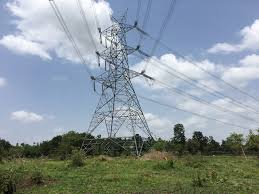Nisha Biswas
People of the villages Khamarait, Machhi Bhanga, Tona, Gazipur etc. of Polerhat 2 Panchayet in Bhangar Assembly Constituency are very agitated. According to them, they are facing desperate situation due to the Government decision to set-up a Power Grid (440/220 KV) in that area. The Power Grid Corporation of India Limited (A Govt. of India Enterprise, PGCIL) is constructing the Rajarhat 400/220 KV, SF6 gas insulated Substation and associated 953 Km (480 Km passing through West Bengal) length of 400KV double circuit, 450MW Transmission lines, to transmit power between West Bengal and Purnia in Bihar costing Rs 1200 crores to evacuate power from NTPC power projects at Farraka in West Bengal and Kahalgoan in Bihar.
The Substation is being setup on forcibly acquired, nearly 16 Acres of highly fertile farmland at Khamarait, two years ago. Taking advantage of the innocence of villagers, they were informed that a power house is to be constructed on the acquired land and also that the transmission lines will be passing along the road sides. In early 2016 when the PGCIL began work of installation of transmission lines support structures (transmission towers) on their fields, without their permission, the villagers became suspicious. They started raising questions to the local Trinamool Congress (TMC) leaderships and to PGCIL authorities. Questions were raised on the use of extremely potent greenhouse gas SF6 (Sulphur Hexaflouride, SF6) and on the effect of electromagnetic field (EMF) that will be generated, once the transmission line becomes operative.
The Fear of Villagers for Sulphur Hexaflouride Leakage is Real
Sulphur Hexafluoride, SF6, commonly known as SF6, is an inorganic, colorless, odorless, non-flammable, extremely potent greenhouse gas, with a global warming potential of 23,900 times that of carbon dioxide[1], is an excellent electrical insulator[2] and is used in the electrical industry as a gaseous dielectric medium for high-voltage circuit breakers, switchgear, and other electrical equipment. More than 10,000 tons of SF6 are produced per year, most of which (over 8,000 tons) is used as a gaseous dielectric medium in the electrical industry.[3] Other main uses of SF6 include an inert gas for the casting of magnesium, and as an inert filling for insulated glazing windows.
According to the Intergovernmental Panel on Climate Change, SF6 is the most potent greenhouse gas that it has evaluated, with a global warming potential of 23,900[1] times that of CO2 when compared over a 100-year period. Measurements of SF6 show that its global average mixing ratio has increased by about 0.2 ppt (parts per trillion, 1trillion = 1 lakh crore) per year to over 7 ppt.[4] Sulfur hexafluoride is also extremely long-lived, is inert in the troposphere and stratosphere and has an estimated atmospheric lifetime of 800–3200 years.[5] Average global SF6 concentrations increased by about seven percent per year during the 1980s and 1990s, mostly as the result of its use in the magnesium production industry, and by electrical utilities and electronics manufacturers. Given the small amounts of SF6 released compared to carbon dioxide, its overall contribution to global warming is estimated to be less than 0.2 percent in 2011[6], but that too is not insignificant considering its increasing uses and long life. In Europe, SF6 falls under the F-Gas (fluorinated greenhouse gas, that is required to be phased out) directive. Since 1 January 2006, SF6 is banned as a tracer gas and in all applications except high-voltage switchgear.[7]
It was reported in 2013 that through a three-year efforts by the United States Department of Energy to identify and fix leaks at its laboratories such as the Princeton Plasma Physics Laboratory, where the gas is used as a high voltage insulator, had been productive, cutting annual leaks by 35,000 pounds. This was done by comparing purchases with inventory, assuming the difference was leaked, then locating and fixing the leaks.[2] In the laboratory set up, the anti-leak efforts though could reduce the leak only into half but was assumed to be a major achievement, equivalent to taking off 200,000 cars off the road for a year.
The most remarkable feature of this accomplishment is, realization of SF6 leaks a real problem. A few years ago, nobody suspected that such a leak problem even existed. The crusade against SF6, stemmed from an executive order early in President Obama’s first term that directed federal agencies to calculate the amount of greenhouse gases their operations generated, and then to work to reduce the totals. Sadly, in India we still do not recognize SF6 leaks a real problem. It was found that the gas leaks made up nearly one-seventh of the total 4.4 million tons of greenhouse gases— the equivalent of about 770,000 tons of carbon dioxide. And more than 90 percent of the leaks were of SF6. The Princeton Plasma Physics Laboratory, a center for nuclear fusion research, the lab with 100,000-volt cables, whose electricity powers equipment that heats plasma to temperatures hundreds of times hotter than the sun’s core, and powers electromagnets that trap the heat in a so-called magnetic bottle, itself was losing 3,200 pounds of sulfur hexafluoride every year, the equivalent of nearly 39,000 tons of carbon dioxide. With the present efforts engineers are able to cut this emission to 920 pounds.
Sulfur hexafluoride or SF6 is a non-toxic gas, yet by displacing oxygen in the lungs, it also carries the risk of asphyxia if too much is inhaled.[8] Being more dense than air, if a substantial quantity of gas is released it will settle in low-lying areas and present a significant risk of asphyxiation if the area is entered. This is particularly relevant to its use as an insulator in electrical equipment where workers may be in trenches or pits below equipment containing SF6.[9] In the present case, where the Rajarhat power grid is installed, is the area where the major occupation of its residents is farm and fish agricultural and SF6 leaks, whatever minimal it is will adversely affect fish farming.
As with all gases, the density of SF6 affects the resonance frequencies of the vocal tract, thus changing drastically the vocal sound qualities, or timbre, of those who inhale it. It does not affect the vibrations of the vocal folds. The density of sulfur hexafluoride is relatively high at room temperature and pressure due to the gas’s large molar mass. Unlike helium, which has a molar mass of about 4 grams/mol and gives the voice a childish and a “chipmunk like” quality, SF6 has a molar mass of about 146 g/mol, and the speed of sound through the gas is about 134 m/s at room temperature, giving the voice a “demonic” quality when SF6 is inhaled.[10] [11] For comparison, the molar mass of air, which is about 80% nitrogen and 20% oxygen, is approximately 30 g/mol which leads to a speed of sound of 343 m/s. Inhalation of SF6 causes a lowering of the timbre, or frequency of the formants, of the vocal tract, by contrast with inhalation of helium, which raises it.[12] Sulfur hexafluoride also has an anesthetic potency slightly lower than nitrous oxide,[13] used in surgery and dentistry for its anesthetic and analgesic effects.
It must also to be mentioned here that as the greenhouse effect of SF6 cannot be ignored, significant amount of research efforts are going on internationally in finding its replacement.[14],[15],[16]
Fear of Living Under Large Electro-Magnetic Field is Genuine
According to a notification of PGCIL of January9, 2014 the transmission lines from Rajarhat substation will be passing over 80 villages of seven districts, namely South 24 Parganas, North 24 Parganas, Nadia, Hooghly, Burdwan, Murshidabad and Birbhum of West Bengal, before entering into Pakur district of the state of Jharkhand. The nine to twelve transmission lines coming out of the Rajarhat Grid will affect more than 30,000 lives only in South 24 Parganas. The land is fertile to the extent that crops are grown all-round the year. There are large number of coconut and tall trees. All kind of vegetables are grown here. The villagers fear that a network of high voltage (400,000V) power lines will affect their lives, livelihood, ecology and environment. There is habitation within 100 feet of Power Grid sub-station.
Power lines carry high-voltage electric current from one place to another. When current flows through a wire, two fields are created around it: an electric field and a magnetic field. These are the two components of the electromagnetic field (EMF). The magnetic portion is the more dangerous because of its ability to penetrate the human body. The strength and extent of this magnetic field depends on three things: how much current is flowing, the voltage, and the configuration of the wires (i.e. how far apart the wires are from each other, and similar other factors). Since power lines may carry huge amounts of current, often at high voltages, substantial electromagnetic fields (EMF) are created. In the case of high-voltage transmission lines, the EMF can extend to about 300 meters. Power Line EMF is strongest directly underneath the power lines, and gradually fades away with increasing distance. Many have experienced electric shock while walking under or nearer to these lines with an umbrella overhead even on a clear day. The field is so high that if one places florescent tube under the current carrying high voltage wire, it lights itself without any electric connection. There are plenty of demonstrations of florescent lights glowing on youtube.com, but the best is hundreds of florescent light installation under 400KV line by Richard Box of Bristol University.[17]
Concern for Human Health
There has been concern over power line radiation and its effect on human health for at least 40 years. Living close to power lines has been shown to increase the risk of leukemia and other cancers since 1979, when convincing evidence was first published by Wertheimer and Leeper in the American Journal of Epidemiology.[18] Since then, dozens of published papers have found links between living near power lines (and other electrical wiring configurations) and a range of health woes, including brain cancer, childhood and adult leukemia, Lou Gehrig’s disease (ALS), Alzheimer’s disease, breast cancer in women and men, miscarriage, birth defects and reproductive problems, decreased libido, fatigue, depression and suicide, blood diseases, hormonal imbalances, heart disease, neuro-degenerative diseases, sleeping disorders and many others.
To appreciate the sheer weight of this evidence, see the excellent list of published research papers compiled by Powerwatch UK[19] which identifies over 300 papers relating to EMF from power lines and electricity sub-stations. Of these, more than 200 were able to find a link between this type of radiation and (mostly) harmful biological effects. It is extremely unlikely that all these studies were mistaken in their conclusions. But in some cases, subsequent studies which tried to replicate the original results have failed to confirm the effect. Therefore, though the evidence cannot be considered to be 100% conclusive for any of the diseases mentioned, but must be taken seriously.
Response of Governmental Agencies
Environmental agencies, health organizations and power-industry spokesmen generally stress the weaknesses of the evidence, inconsistencies in the data, and lack of conclusive proof. Government organizations (which fund many of the studies) may not wish to promote the view that power line EMF can cause disease. People would ask “why have you allowed this health hazard?” The same applies to the power distribution industry. Research studies can be structured so as to demonstrate whatever conclusions their sponsors would like to promote.
Big money, from government and industry, could be backing the (minority of) research which fails to find health effects from power line radiation. These large and powerful organizations greatly influence public (and even scientific) opinion. Therefore, the evidence for EMF health effects will likely remain inconclusive, and may never be sufficient to prove unequivocally that long-term exposure to low-level, low-frequency EMF actually causes disease.
More Proofs
Meanwhile, many more scientists have investigated EMF exposure and health. Although earlier studies did suggest associations between exposure and a variety of health effects including brain cancer, breast cancer, cardiovascular disease, and reproductive and developmental disorders, most of these associations have not been substantiated by more recent research. One notable exception to this is the association with childhood leukemia, which the International Agency for Research on Cancer regards as sufficiently well established to rate extremely low frequency magnetic fields as a “possible” human carcinogen.[20]
British and Australian researchers, jointly, in 2007, analyzed a unique database that included lifetime addresses of all patients in Tasmania diagnosed with lymphatic and bone marrow cancers between 1972 and 1980. The patients were aged from 0 to 94 years. The results suggest that those who lived within 300 meters of a power line up to the age of five were five times more likely to develop cancers, while those who lived that close to a power line at any point during their first 15 years of life were three times more likely to develop one of these cancers as an adult. Furthermore, the researchers found that people who had lived within 50 meters of a high- voltage power line at any time were at double the risk of developing the cancers studied than those who had never lived within 300 meters of a power line. For every year lived within 50 meters of a power line, the risk of developing one of these cancers increased by 7 per cent. There was also evidence that the risk of cancer increased with higher voltages[21].
A similar study done in 2005 in British Columbia, showed an elevated risk of leukemia among children living in homes with distances much greater than 60 m from high voltage power lines.[22] This study involved close to 30000 matched case-control pairs of children living in the United Kingdom. It was found that children living in homes as far as 600 m from power lines had an elevated risk of leukemia. An increased risk of 69% for leukemia was found for children living within 200 m of power lines while an increased risk of 23% was found for children living within 200 to 600 m of the lines.[22] This study was notable in that it found some elevation of risk at much greater distances than previous studies.
Although distance of homes from power lines can be considered a crude measure of exposure, the results of this study do merit attention. A limited understanding exists of how exposure to EMF can affect health. The underlying biological mechanism is unknown, making it difficult to determine which measure of EMF is most appropriate when evaluating health outcomes. Use of residential proximity may be a reasonable surrogate for direct measurements of EMF, but may also reflect other factors that are related to proximity to high voltage lines. If the association found in these studies do reflect a causal relationship, what are the potential impacts, using current BC leukemia rates[23] and assuming similar proportions of the population live near high voltage lines, on a statistical basis, there may be one additional leukemia in BC every 2 years. To eliminate this risk, one would need to achieve a separation distance of 600 m between every high voltage power line and the nearest residence. While this could be done, it would require substantial changes to existing land use patterns and would require significant resources.
Concern for Live Stocks
Many researchers are studying the effect of Electrostatic field on animals. In order to do so they keep the cages of animals under high Electrostatic field of about 30 kV/m. The results of these Experiments are shocking as animals (are kept below high Electrostatic field their body acquires a charge & when they try to drink water, a spark usually jumps from their nose to the grounded Pipe) like hens are unable to pick up grain because of chattering of their beaks which also affects their growth. A 2003 study conducted by Dr Donald Hillman[24] shows animal behavior and milk production was affected to the extent that milk production was reduced by 10 to 15%.
It was, for the first time, on October 24, 2008, a civil court at Tulle (France) declared RTE (responsible for the distribution of electricity) 400KV power lines to be the cause of disease in a herd of cattle. It was for the first time the courts have established that there is a link between the effects of electromagnetic radiation from a very high voltage power line and the onset of disease among animals. The Civil Court at Tulle ordered the national electricity distribution network (RTE) to pay 390,648 euros to cattle farmers.[25]
The high-voltage line at Latronche was upgraded in 1990 to a line of very high voltage (carrying 400,000 or more volts). The Marcouyoux family, who ran the farm specializing in raising cows and pigs, soon noticed that their animals were showing symptoms of disease – breathing problems, weakened immune systems – but it was only in 1998, after years of visiting vets, that a technician concluded that the animals were over-exposed to electromagnetic radiation, while the local farming authority and the county veterinary services eliminated any source of infection as the cause of death of the cows. Marcouyox family stopped raising new litters of pigs because of abnormally low birth rate and a high rate of infant mortality. The barn contained undersize heifers, some of them afflicted with hemorrhages or inexplicable abortions and 10% of the milk was lost because of the digestive or genital diseases that the cows suffer from.
It has been studied by Hynek Burda[26] the effect of power lines on the magnetic alignment ability of cows and other herding animals. The uncanny ability of the cattle of herds to point in the same direction gets disturbed near high-voltage power lines, which emit strong magnetic fields, disrupts their orientation. Near these lines, their neat alignment goes astray and they position themselves at random creating chaos. The same is found in the case of fishes.
Then there is audible noise emitted from high-voltage lines, caused by the discharge of energy that occurs when the electrical field strength on the conductor surface is greater than the ‘breakdown strength’ (the field intensity necessary to start a flow of electric current) of the air surrounding the conductor. This discharge is also responsible for radio noise, disturbance in audio and video reception, a visible glow of light near the conductor, an energy loss known as corona loss and other phenomena associated with high-voltage lines. The intensity of the corona discharge and the resulting audible noise are affected by the condition of the air-that is, by humidity, air density, wind and water in the form of rain, drizzle and fog. Water increases the conductivity of the air and so increases the intensity of the discharge. The higher voltages at which modern transmission lines operate have increased the noise problem to the point to which they have become a concern to the power industry.[27] The magnitude of the problem can be understood by the complaint that the above 60 years old Marcouyox made that he and his wife became deaf and that his son has breathing problems.
Concern for Crops
Increase in demand for electricity, sees a growth in number of electric transmission lines which cross the country side. Lengthy segments of these power lines pass directly through productive agricultural land. The crop producers whose fields are traversed by overhead transmission lines are affected in two ways,
Power line support structure is a physical obstruction that impedes machinery field operations and precludes a certain area from being cropped (pole effect), which results in time loss, and thereby financial loss, due to increased labour and machinery time (required to work around support structure) throughout the cropping season;
Area loss – a support structure precludes certain area directly beneath the structure (350 sqm to 750sqm) from being planted or harvested, resulting in decrease in crop production; and
Yield loss due to Wire effect – depressed or reduced yield in the vicinity of power lines mainly due to crop stress caused by electromagnetic field beneath the transmission lines.
Apart from the above, the support structure is usually laid on raised platforms, so as in case of heavy rain, the structures do not submerge or damaged. These raised platforms disrupt the draining system of the field, and it is generally seen that after rains such fields take longer time in drying and disrupting the next cropping cycle.
Moreover, because of corona[26] the tall trees like coconut palm, areca nut palm, date palm etc., get burnt to the extent that the coconut water dries up and the kernel gets burnt and becomes black and useless because of electric discharge. Many times one sees the tips of the leaves of the tree blackened, putting trees under chlorophyll stress. The darkening of the ears of maize crop is also noticed. The EMF generated by LFHV transmission lines exert a stress on crop growing under and in the vicinity of transmission lines leading to loss in production and hence economic loss.[28]
The apathy of the government towards the farmers above whose land the transmission lines are passing can be seen by the fact that no clearance from environment ministry is required whereas the same is required if the lines pass forest area under the Forest Conservation Act. Once a transmission line is laid, the farmer has to forfeit most of his rights over his land, crop and plantation. In the name of preventing damages due to ‘flash overs’, maintenances, of line the power line installing company has unfettered rights of cutting the tall trees, entering into the fields and thereby damaging standing crops, year after year.
Moreover, the transmission-line support structures and lines are laid near and within the ponds, where the farmers cultivate fish. The support structure within or near to the pond changes its ecology and make them unfit for fish cultivation. Also the generated EMF overhead, changes the growth and breeding pattern of fishes, for which farmers suffer substantial losses. For installation of support structure, the ponds, fish embankments (bheries) have to be dried and the machine and human activity that will go on in installation of towers will grievously damage the soil bed, swamp and under-bed micro-organisms, making them unfit for fish cultivation. Like on cows, electro-magnetic field, affects the magnetic alignment ability of fish and disrupts their movement. And then, there are certain fishes, who refuse to move in high EMF.
Continuum of Betrayal
Since 2015, from the day work on forcibly acquired land initiated, people were first reassured that a small power house would be built in the area to cater local and neighbourhoods demand. Later, people learnt that the project was being planned at a much massive scale and it is not a power house that they were made to believe, but is a 400KV power grid. Even then they reassured by the local Grid management, that their work is limited to the acquired 16Acre land and no further. Things came to stand still, when PGCIL started installing transmission line support structures (towers) on their field without taking their consent, without following the Guidelines for payment of Compensation towards damages in regard to Right of Way for transmission line, Ministry of Power, Government of India, 15.10.2015. When people resisted such constructions on their fields, PGCIL started paying pittance, not following the above guidelines.
In this matter the local administration and ruling political party leadership too worked in tandem with PGCIL. The spread of lies is to the extent that a notification, dated 22.10.2016, by PGCIL says that the said ‘project will benefit mostly Rajarhat, Bhangar, and large areas of South & North 24Parganas’, which is a lie. West Bengal is generating power excess to that it can utilize, therefore question of supplying electricity to Rajarhat, Bhangar etc. through this grid does not arise. Moreover, 440KV power lines are not meant for supplying power for local necessities.
Furthermore, PGCIL is not informing people that the lines will be drawn till Purnia in Bihar, crossing Jharkhand, whereas, page5 of the “Progress Report till March 2016 of the status of Power Grid project: Transmission lines”[29] and the notification dated 09.01.2014, as mentioned above, do gives details of the proposed construction.
And then there is jugglery of words, when the locals raise their apprehensions about disposal of waste from the GRID, the notification of 26.10.2016 says power grid is not planning to construct canal from this substation. It is not clear how the waste will be disposed of and what measures PGCIL is taking to make it pollutant free.
People were also informed by PGCIL authorities and local administration that the land required for putting up the support structure (tower) is the only loss that they have to incur for larger benefit to the society, but the notification dated 29.12.2016 by PGCIL[30] directs people not to make any construction, installation of metal pole or bamboo pole or climb on the tower under or closer to 400KV DC Jirat-Subhash Gram transmission line, which will be electrified from the same date, and that if no person follows the above instructions then he or she will be solely responsible for any untoward incident or accident. This all is fueling the suspicion and people are apprehensive of the ulterior motives PGCIL.
Developing Movement
Not falling in line, to intimidate, PGCIL took help of administration and police, 6 persons (including 3 women) were arrested on 3rd November 2016 and imprisoned for 20days. Among them there was one Noorjahan, who was accompanying her small son to local primary school. All this has not worked in favour of PGCIL, and has made people suspicious of the activities of PGCIL. A movement is developed against the acquisition of 16 acres of farmland and putting up of transmission lines. The villages of Khamarait, Machhi Bhanga, Tona and Gazipur in the Bhangar II block have been on the boil in the last few months. A committee named– Jomi, Jibika, Poribesh O Bastutantra Raksha Committee – has been formed to lead the protest.
People have been getting organized under the banner of Jomi, Jibika, Poribesh O Bastutantra Raksha Committee, against the power grid and administration. They have come out on the streets in protest. They have submitted a memorandum to the SDO recording their opposition to the operation of the power grid in the midst of fertile agricultural land. The PGCI authorities promised to meet them and hear their grievances, but on the scheduled day, when the people of the area arrived at the PGCI office, the officers had already locked up the office and left, afraid to meet the people. They have also filed complaints with local Kashipur PS, under whose jurisdiction the area is, against forcefully putting up towers against their will.
On December 22, 2016 they brought Kolkata roads to a standstill in a massive rally. Braving the threats and intimidations more than 10,000 people came to Kolkata to force the state government to listen to their woes and to hand over a memorandum to the Governor of West Bengal. Governor, though agreeing to meet, finally did not meet them, but the people of Kolkata were made aware by taking out a massive rally that Kolkata has not seen for last ten years.
Threatened by the massive turnout and positive support in favour of Bhangar movement, ruling party, Trinamool Congress leadership is trying hard to make people see the gains, which are not there, and let the PGCIL work continue unhindered. In this respect a meeting was held by senior leaders of TMC on December25, 2016. The place was filled up by bringing people from other places.
It is said that many of them left the meeting after realizing that the meeting was in support of PGCIL work, whereas they were brought in with the promise of protesting against it. Local participation was almost nil. The abusive language, false promises and statements has made people of Bhangar angrier, and they spontaneously decided to hold a meeting on December28 at Khamarait. But, with the aim to suppress the movement, on December 27, Section 144 was imposed in a radius of 1.5 km surrounding Khamarait, and gatherings of more than four people were subject to arrest. Employees and officials of PGCIL were exempt from Section 144. It was the same tactic that the then government used in suppressing Singur movement ten years back.
Where, life, livelihood is at stake, no Sec 144 can deter the resolute of people. On December 28, a huge gathering of several thousand people took place at Machhibhanga. People coming in vehicles from Deganga, Beleghata, and other places, arrived on foot after being stopped by the police to express their resolute of not letting PGCIL and administration continue with its anti-people activities and deprive them of their life, livelihood, ecology and environment, even when the roads leading to the meeting were manned by police and the hired goons of the ruling Party.
References
[1] ”2.10.2 Direct Global Warming Potentials”. Intergovernmental Panel on Climate Change. 2007.
[2] Michael Wines (June 13, 2013). ”Department of Energy’s Crusade Against Leaks of a Potent Greenhouse Gas Yields Results”. The New York Times.
[3] Constantine T. Dervos; Panayota Vassilou (2012). Sulfur Hexafluoride: Global Environmental Effects and Toxic Byproduct Formation. Taylor and Francis.
[4] ”Chromatograph for Atmospheric Trace Species SF6 Mixing Ratio”. US National Oceanic and Atmospheric Administration.
[5] A. R. Ravishankara, S. Solomon, A. A. Turnipseed, R. F. Warren; Solomon; Turnipseed; Warren (8 January 1993). ”Atmospheric Lifetimes of Long-Lived Halogenated Species”. Science. 259 (5092): 194–199. Bibcode:1993Sci…259..194R. doi:10.1126/science.259.5092.194. PMID 17790983.
[6] ”SF6 Sulfur Hexafluoride”. PowerPlantCCS Blog. 19 March 2011.
[7] ”Climate: MEPs give F-gas bill a ‘green boost’”. EurActiv.com. 13 October 2005.
[8] ”Sulfur Hexaflouride”. Hazardous Substances Data Bank. U.S. National Library of Medicine.
[9] ”Guide to the safe use of SF6 in gas”. UNIPEDE/EURELECTRIC.
[10] ”Thermophysical Properties of Fluid Systems”. NIST.
[11] ”Have You Ever Wanted to Sound Like a Demon? Here’s How”. Science Explorer,May 31, 2016.
[12] ”Physics in Speech”. University of New South Wales.
[13] Adriani, John (1962). The Chemistry and Physics of Anesthesia. Second Edition. Illinois: Thomas Books. p. 319. ISBN 9780398000110.
[14] https://www.epa.gov/f-gas…/possible-present-and-future-alternatives-pure-sf6
[15] https://www.epa.gov/f-gas-partnership…/research-and-findings-alternatives-pure-sf6
[16] www.tdeurope.eu/data/SF6% 20PP28042015.pdf
[17] https://youtu.be/cXhZvyGtMrk
[18] ”Electrical wiring configurations and childhood cancer”, Am J Epidemiol 1979; 109 (3): 273-284
[19] http://www.powerwatch.org.uk/science/studies.asp#elfemf
[20] World Health Organization. Extremely low frequency fields environmental health criteria monograph no. 238. 2007. www.who.int/peh-emf/publications/elf_ehc/en/index.html
[21]”Residential exposure to electric power transmission lines and risk of lymphoproliferative and myeloproliferative disorders: a case-control study”, Lowenthal R. M., Tuck D. M., and Bray I. C. Internal Medicine Journal, 37(9):614-619 (2007)
[22] Draper G, Vincent T, Kroll ME, et al. Childhood cancer in relation to distance from high voltage power lines in England and Wales: A case-control study. BMJ 2005; 330:1290.
[23] BC Cancer Agency. Leukemia. 2008. www.bccancer.bc.ca/NR/rdonlyres/AC6262BC-634F-4227-BF14-163182197EDF/25977/leukemia1.pdf
[24] Hillman, D., D. Stetzer, M. Graham, C. Goeke, K. Mathson, H. VanHorn, C. Wilcox. 2003. Relationship of electric power quality to milk production and ( behavior of dairy cattle. Paper No. 033116, Amer. Soc. Agr. Engineers, St. Joseph.
[25] http://www.next-up.org/pdf/AFP judgment Electromagnetic Radiation Power Line Disease Animals14112008.pdf
[26] https://www.sciencenews.org/article/compass-cr.
(Nisha Biswas is a retired scientist and activist based in Kolkata)


















